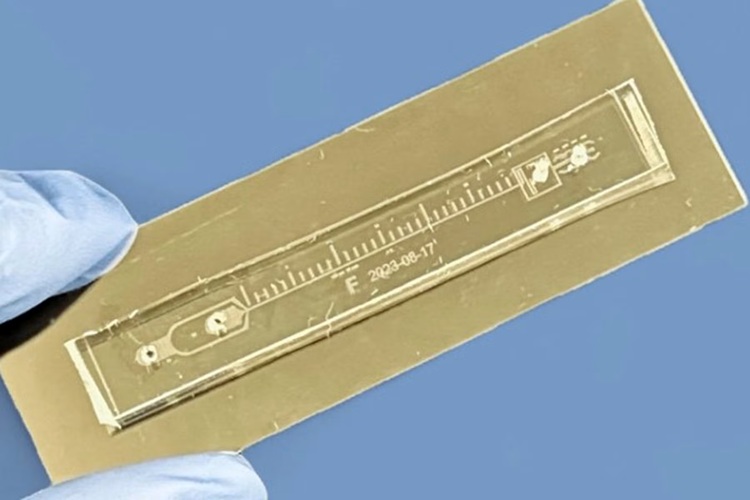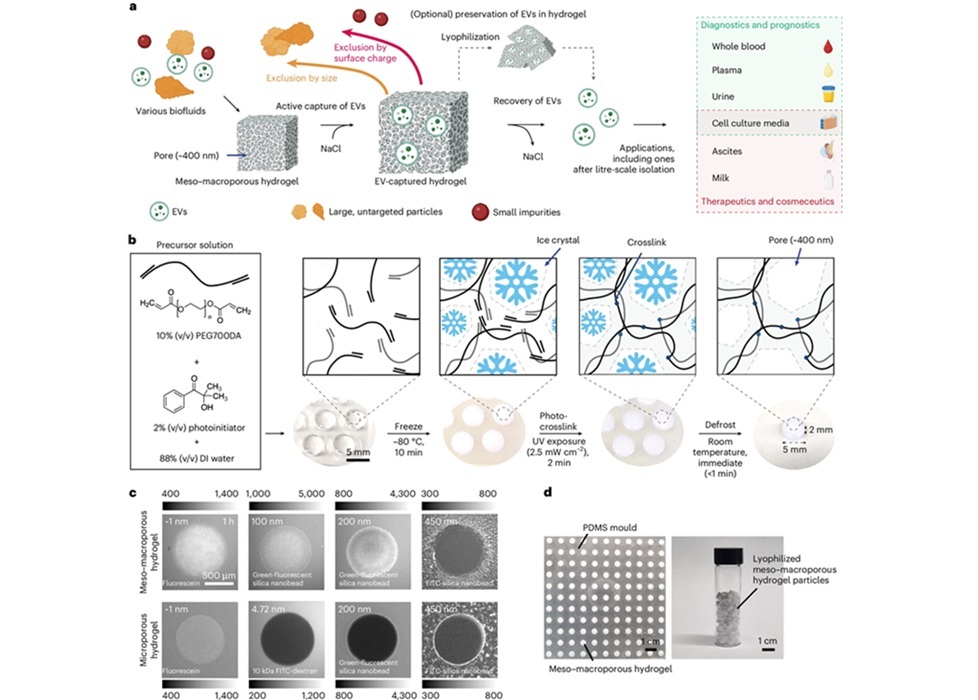Presenilin Gene Mutation Linked to Familial form of Alzheimer's Disease
|
By LabMedica International staff writers Posted on 24 Mar 2015 |

Image: Comparing sections of cortex from a control mouse (left) to a mouse with a presenilin-1 mutation (right). The dashed line indicates the surface of the brain. Presenilin-1 mutations decrease gamma-secretase activity and cause features of neurodegeneration, including shrinkage of the cortex, as shown above (Photo courtesy of Dr. Raymond Kelleher and Dr. Jie Shen, Harvard Medical School).
Results obtained in studies using a genetically engineered mouse model of hereditary Alzheimer's disease pointed to the importance of reduced gamma-secretase activity caused by a mutation in the presenilin (PSEN1) gene.
Most cases of Alzheimer's disease are not hereditary. However, there is a small subset of cases that have an earlier age of onset and have a strong genetic element. In patients suffering from this form of Alzheimer's disease (autosomal dominant hereditary), mutations in the presenilin proteins (PSEN1 and PSEN2) or the amyloid precursor protein (APP) can be found. The majority of these cases carry mutant presenilin genes. An important factor in the disease process in AD is the accumulation of amyloid beta (Abeta) protein. To form Abeta, APP must be cut by two enzymes, beta-secretase and gamma-secretase. Presenilin is the sub-component of gamma-secretase that is responsible for the cutting of APP. Individuals with a hereditary form of AD over produce type 42 amyloid beta protein (Abeta42), which readily accumulates in the amyloid plaques that characterize the disease.
Investigators at Harvard Medical School (Boston, MA, USA) generated PSEN1 knockin (KI) mice carrying the familial Alzheimer’s disease (FAD) mutation L435F or C410Y.
They reported in the March 4, 2015, online edition of the journal Neuron that KI mice homozygous for either mutation recapitulated the phenotypes of mice that had been genetically engineered to completely lack PSEN1. Neither mutation altered PSEN1 mRNA expression, but both abolished gamma-secretase activity. Heterozygosity for the KI mutation decreased production of Abeta40 and Abeta42, increased the Abeta42/Abeta40 ratio, and increased Abeta deposition. In addition, the L435F mutation impaired hippocampal synaptic plasticity and memory and caused age-dependent neurodegeneration in the aging cerebral cortex. Collectively, the findings revealed that FAD mutations could cause complete loss of presenilin-1 function in vivo, suggesting that clinical PSEN mutations produce FAD through a loss-of-function mechanism.
"This is a very striking example where we have mutations that inactivate gamma-secretase function and yet they trigger an array of features that resemble Alzheimer's disease, notably synaptic and cognitive deficits as well as neurodegeneration," said senior author Dr. Raymond Kelleher, professor of neurology at Harvard Medical School. "This study is the first example of a mouse model in which a familial Alzheimer's mutation is sufficient to cause neurodegeneration. The new model provides an opportunity that we hope will help with the development of therapies focusing on the devastating neurodegenerative changes that occur in the disease."
Related Links:
Harvard Medical School
Most cases of Alzheimer's disease are not hereditary. However, there is a small subset of cases that have an earlier age of onset and have a strong genetic element. In patients suffering from this form of Alzheimer's disease (autosomal dominant hereditary), mutations in the presenilin proteins (PSEN1 and PSEN2) or the amyloid precursor protein (APP) can be found. The majority of these cases carry mutant presenilin genes. An important factor in the disease process in AD is the accumulation of amyloid beta (Abeta) protein. To form Abeta, APP must be cut by two enzymes, beta-secretase and gamma-secretase. Presenilin is the sub-component of gamma-secretase that is responsible for the cutting of APP. Individuals with a hereditary form of AD over produce type 42 amyloid beta protein (Abeta42), which readily accumulates in the amyloid plaques that characterize the disease.
Investigators at Harvard Medical School (Boston, MA, USA) generated PSEN1 knockin (KI) mice carrying the familial Alzheimer’s disease (FAD) mutation L435F or C410Y.
They reported in the March 4, 2015, online edition of the journal Neuron that KI mice homozygous for either mutation recapitulated the phenotypes of mice that had been genetically engineered to completely lack PSEN1. Neither mutation altered PSEN1 mRNA expression, but both abolished gamma-secretase activity. Heterozygosity for the KI mutation decreased production of Abeta40 and Abeta42, increased the Abeta42/Abeta40 ratio, and increased Abeta deposition. In addition, the L435F mutation impaired hippocampal synaptic plasticity and memory and caused age-dependent neurodegeneration in the aging cerebral cortex. Collectively, the findings revealed that FAD mutations could cause complete loss of presenilin-1 function in vivo, suggesting that clinical PSEN mutations produce FAD through a loss-of-function mechanism.
"This is a very striking example where we have mutations that inactivate gamma-secretase function and yet they trigger an array of features that resemble Alzheimer's disease, notably synaptic and cognitive deficits as well as neurodegeneration," said senior author Dr. Raymond Kelleher, professor of neurology at Harvard Medical School. "This study is the first example of a mouse model in which a familial Alzheimer's mutation is sufficient to cause neurodegeneration. The new model provides an opportunity that we hope will help with the development of therapies focusing on the devastating neurodegenerative changes that occur in the disease."
Related Links:
Harvard Medical School
Latest BioResearch News
- Genome Analysis Predicts Likelihood of Neurodisability in Oxygen-Deprived Newborns
- Gene Panel Predicts Disease Progession for Patients with B-cell Lymphoma
- New Method Simplifies Preparation of Tumor Genomic DNA Libraries
- New Tool Developed for Diagnosis of Chronic HBV Infection
- Panel of Genetic Loci Accurately Predicts Risk of Developing Gout
- Disrupted TGFB Signaling Linked to Increased Cancer-Related Bacteria
- Gene Fusion Protein Proposed as Prostate Cancer Biomarker
- NIV Test to Diagnose and Monitor Vascular Complications in Diabetes
- Semen Exosome MicroRNA Proves Biomarker for Prostate Cancer
- Genetic Loci Link Plasma Lipid Levels to CVD Risk
- Newly Identified Gene Network Aids in Early Diagnosis of Autism Spectrum Disorder
- Link Confirmed between Living in Poverty and Developing Diseases
- Genomic Study Identifies Kidney Disease Loci in Type I Diabetes Patients
- Liquid Biopsy More Effective for Analyzing Tumor Drug Resistance Mutations
- New Liquid Biopsy Assay Reveals Host-Pathogen Interactions
- Method Developed for Enriching Trophoblast Population in Samples
Channels
Clinical Chemistry
view channel
Chemical Imaging Probe Could Track and Treat Prostate Cancer
Prostate cancer remains a leading cause of illness and death among men, with many patients eventually developing resistance to standard hormone-blocking therapies. These drugs often lose effectiveness... Read more
Mismatch Between Two Common Kidney Function Tests Indicates Serious Health Problems
Creatinine has long been the standard for measuring kidney filtration, while cystatin C — a protein produced by all human cells — has been recommended as a complementary marker because it is influenced... Read moreMolecular Diagnostics
view channel
Microfluidic Device Predicts Pancreatic Cancer Recurrence After Surgery
Pancreatic ductal adenocarcinoma is one of the deadliest cancers, difficult to detect early, and prone to recurring in nearly 70% of patients after treatment. Its location deep in the abdomen and its aggressive... Read more
New Molecular Test Simultaneously Detects Three Major Fungal Infections
Serious fungal infections associated with soil exposure remain difficult to diagnose promptly, especially in regions where Histoplasma, Blastomyces, and Coccidioides are endemic. Many patients present... Read moreHematology
view channel
Platelet Activity Blood Test in Middle Age Could Identify Early Alzheimer’s Risk
Early detection of Alzheimer’s disease remains one of the biggest unmet needs in neurology, particularly because the biological changes underlying the disorder begin decades before memory symptoms appear.... Read more
Microvesicles Measurement Could Detect Vascular Injury in Sickle Cell Disease Patients
Assessing disease severity in sickle cell disease (SCD) remains challenging, especially when trying to predict hemolysis, vascular injury, and risk of complications such as vaso-occlusive crises.... Read more
ADLM’s New Coagulation Testing Guidance to Improve Care for Patients on Blood Thinners
Direct oral anticoagulants (DOACs) are one of the most common types of blood thinners. Patients take them to prevent a host of complications that could arise from blood clotting, including stroke, deep... Read moreImmunology
view channel
Chip Captures Cancer Cells from Blood to Help Select Right Breast Cancer Treatment
Ductal carcinoma in situ (DCIS) accounts for about a quarter of all breast cancer cases and generally carries a good prognosis. This non-invasive form of the disease may or may not become life-threatening.... Read more
Blood-Based Liquid Biopsy Model Analyzes Immunotherapy Effectiveness
Immunotherapy has revolutionized cancer care by harnessing the immune system to fight tumors, yet predicting who will benefit remains a major challenge. Many patients undergo costly and taxing treatment... Read moreMicrobiology
view channel
Blood-Based Molecular Signatures to Enable Rapid EPTB Diagnosis
Extrapulmonary tuberculosis (EPTB) remains difficult to diagnose and treat because it spreads beyond the lungs and lacks easily accessible biomarkers. Despite TB infecting 10 million people yearly, the... Read more
15-Minute Blood Test Diagnoses Life-Threatening Infections in Children
Distinguishing minor childhood illnesses from potentially life-threatening infections such as sepsis or meningitis remains a major challenge in emergency care. Traditional tests can take hours, leaving... Read more
High-Throughput Enteric Panels Detect Multiple GI Bacterial Infections from Single Stool Swab Sample
Gastrointestinal (GI) infections are among the most common causes of illness worldwide, leading to over 1.7 million deaths annually and placing a heavy burden on healthcare systems. Conventional diagnostic... Read morePathology
view channel
AI Tool to Transform Skin Cancer Detection with Near-Perfect Accuracy
Melanoma continues to be one of the most difficult skin cancers to diagnose because it often resembles harmless moles or benign lesions. Traditional AI tools depend heavily on dermoscopic images alone,... Read more
Unique Immune Signatures Distinguish Rare Autoimmune Condition from Multiple Sclerosis
Myelin oligodendrocyte glycoprotein antibody–associated disease (MOGAD) is a rare autoimmune disorder in which the immune system attacks the myelin sheath in the central nervous system. Although symptoms... Read moreTechnology
view channel
AI Saliva Sensor Enables Early Detection of Head and Neck Cancer
Early detection of head and neck cancer remains difficult because the disease produces few or no symptoms in its earliest stages, and lesions often lie deep within the head or neck, where biopsy or endoscopy... Read more
AI-Powered Biosensor Technology to Enable Breath Test for Lung Cancer Detection
Detecting lung cancer early remains one of the biggest challenges in oncology, largely because current tools are invasive, expensive, or unable to identify the disease in its earliest phases.... Read moreIndustry
view channel
Abbott Acquires Cancer-Screening Company Exact Sciences
Abbott (Abbott Park, IL, USA) has entered into a definitive agreement to acquire Exact Sciences (Madison, WI, USA), enabling it to enter and lead in fast-growing cancer diagnostics segments.... Read more




 assay.jpg)





















